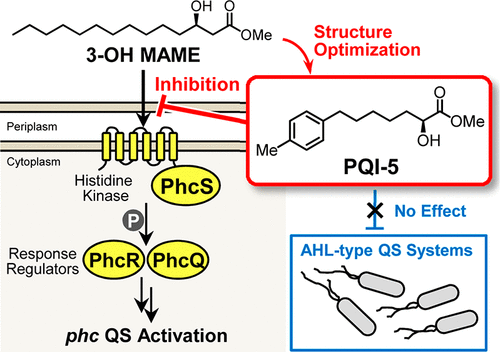当前位置:
X-MOL 学术
›
ACS Chem. Biol.
›
论文详情
Our official English website, www.x-mol.net, welcomes your
feedback! (Note: you will need to create a separate account there.)
Quorum Sensing Inhibition Attenuates the Virulence of the Plant Pathogen Ralstonia solanacearum Species Complex
ACS Chemical Biology ( IF 3.5 ) Pub Date : 2020-11-10 , DOI: 10.1021/acschembio.0c00752 Ayaka Yoshihara 1 , Mika Shimatani 1 , Megumi Sakata 1 , Chika Takemura 2 , Wakana Senuma 2 , Yasufumi Hikichi 2 , Kenji Kai 1
ACS Chemical Biology ( IF 3.5 ) Pub Date : 2020-11-10 , DOI: 10.1021/acschembio.0c00752 Ayaka Yoshihara 1 , Mika Shimatani 1 , Megumi Sakata 1 , Chika Takemura 2 , Wakana Senuma 2 , Yasufumi Hikichi 2 , Kenji Kai 1
Affiliation

|
Strains of Ralstonia solanacearum species complex (RSSC) cause “bacterial wilt” on a wide range of plant species and thus lead to marked economic losses in agriculture. Quorum sensing (QS), a bacterial cell–cell communication mechanism, controls the virulence of RSSC strains by regulating the production of extracellular polysaccharide (EPS) and secondary metabolites, biofilm formation, and cellular motility. R. solanacearum strain OE1-1 employs (R)-methyl 3-hydroxymyristate (3-OH MAME) as a QS signal, which is synthesized by the PhcB methyltransferase and sensed by the PhcS/PhcRQ two-component system. We describe the design, synthesis, and biological evaluation of inhibitors of the phc QS system. Initial screening of a small set of QS signal analogues revealed that methyl 3-hydroxy-8-phenyloctanoate, named, PQI-1 (phcquorum sensing inhibitor-1), inhibited biofilm formation by strain OE1-1. To improve its inhibitory activity, the derivatives of PQI-1 were synthesized, and their QS inhibition activities were evaluated. PQIs-2–5 evolved from PQI-1 more strongly inhibited not only biofilm formation but also the production of ralfuranone and EPS. Furthermore, RNA-Seq analysis revealed that the PQIs effectively inhibited QS-dependent gene expression and repression in strain OE1-1. On the other hand, the PQIs did not affect the canonical QS systems of the representative reporter bacteria. These antagonists, especially PQI-5, reduced wilting symptoms of the tomato plants infected with strain OE1-1. Taken together, we suggest that targeting the phc QS system has potential for the development of chemicals that protect agricultural crops from bacterial wilt disease.
中文翻译:

群体感应抑制抑制减弱植物病原体Ralstonia solanacearum种复合体的毒性。
株青枯雷尔氏菌对多种植物物种复杂(RSSC)因“细菌性枯萎病”,从而导致农业标志着经济损失。群体感应(QS)是一种细菌细胞间的通信机制,它通过调节细胞外多糖(EPS)和次级代谢产物的产生,生物膜的形成以及细胞运动来控制RSSC菌株的毒力。青枯雷尔氏菌菌株OE1-1使用(R)3-羟基肉豆蔻酸甲酯(3-OH MAME)作为QS信号,该信号由PhcB甲基转移酶合成并由PhpS / PhcRQ两组分系统检测。我们描述了phc抑制剂的设计,合成和生物学评估QS系统。一小套QS信号类似物的初步筛选表明,3-羟基-8- phenyloctanoate,命名PQI-1(p HC q uorum传感我nhibitor-1),抑制菌株OE1-1形成生物膜。为了提高其抑制活性,合成了PQI-1的衍生物,并评估了其QS抑制活性。从PQI-1进化而来的PQIs-2-5不仅抑制了生物膜的形成,而且还抑制了呋喃酮和EPS的产生。此外,RNA-Seq分析显示,PQI可有效抑制OE1-1菌株中QS依赖性基因的表达和阻抑。另一方面,PQI不会影响代表性报道细菌的规范QS系统。这些拮抗剂,特别是PQI-5,可以减轻感染OE1-1菌株的番茄的萎symptoms症状。综上所述,我们建议针对phc QS系统具有开发可保护农作物免受细菌性枯萎病侵袭的化学药品的潜力。
更新日期:2020-11-21
中文翻译:

群体感应抑制抑制减弱植物病原体Ralstonia solanacearum种复合体的毒性。
株青枯雷尔氏菌对多种植物物种复杂(RSSC)因“细菌性枯萎病”,从而导致农业标志着经济损失。群体感应(QS)是一种细菌细胞间的通信机制,它通过调节细胞外多糖(EPS)和次级代谢产物的产生,生物膜的形成以及细胞运动来控制RSSC菌株的毒力。青枯雷尔氏菌菌株OE1-1使用(R)3-羟基肉豆蔻酸甲酯(3-OH MAME)作为QS信号,该信号由PhcB甲基转移酶合成并由PhpS / PhcRQ两组分系统检测。我们描述了phc抑制剂的设计,合成和生物学评估QS系统。一小套QS信号类似物的初步筛选表明,3-羟基-8- phenyloctanoate,命名PQI-1(p HC q uorum传感我nhibitor-1),抑制菌株OE1-1形成生物膜。为了提高其抑制活性,合成了PQI-1的衍生物,并评估了其QS抑制活性。从PQI-1进化而来的PQIs-2-5不仅抑制了生物膜的形成,而且还抑制了呋喃酮和EPS的产生。此外,RNA-Seq分析显示,PQI可有效抑制OE1-1菌株中QS依赖性基因的表达和阻抑。另一方面,PQI不会影响代表性报道细菌的规范QS系统。这些拮抗剂,特别是PQI-5,可以减轻感染OE1-1菌株的番茄的萎symptoms症状。综上所述,我们建议针对phc QS系统具有开发可保护农作物免受细菌性枯萎病侵袭的化学药品的潜力。































 京公网安备 11010802027423号
京公网安备 11010802027423号